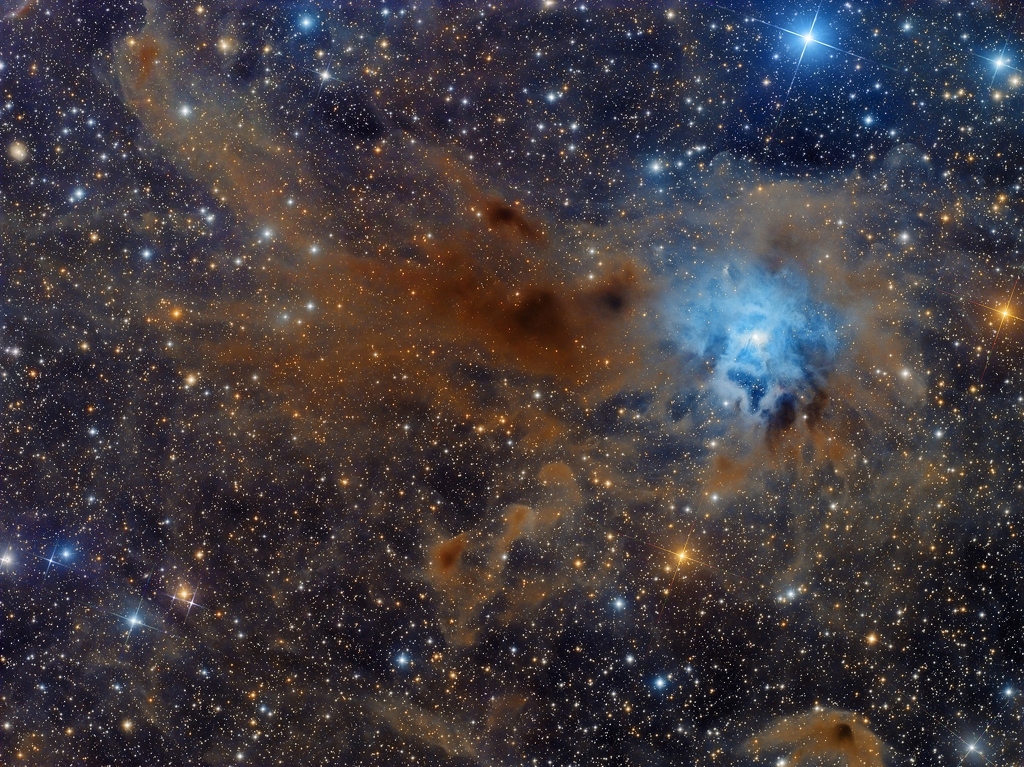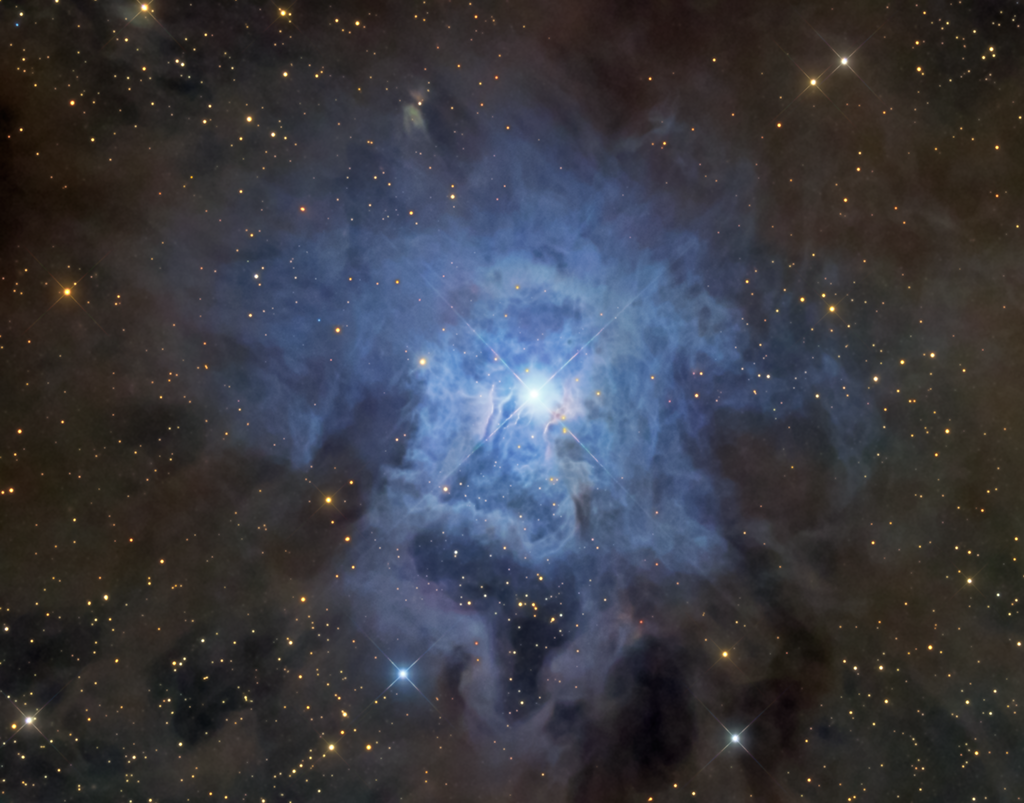The cosmos is adorned with myriad celestial wonders, each telling its own unique story. Among these, the Iris Nebula stands out as a captivating reflection nebula that has intrigued astronomers and astrophotographers alike. Its delicate beauty and the mysteries it holds make it a subject of both scientific study and artistic admiration.

Image Credit & Copyright: Federico Pelliccia
What is the Iris Nebula?
The Iris Nebula, officially designated as NGC 7023 and also known as Caldwell 4, is a prime example of a reflection nebula. Unlike emission nebulae that emit their own light due to ionized gases, reflection nebulae like the Iris Nebula shine by reflecting the light of nearby stars. This particular nebula was discovered by the renowned astronomer Sir William Herschel on October 18, 1794. Its ethereal glow and intricate structures have since made it a focal point in the study of interstellar matter.
Physical Characteristics
Spanning approximately 6 light-years across, the Iris Nebula showcases a complex structure of interstellar dust and gas. Its most striking feature is the bluish hue, resulting from the scattering of light by tiny dust particles, similar to the phenomenon that makes Earth’s sky appear blue. The central region is illuminated by a young, hot star, HD 200775, which is primarily responsible for the nebula’s brightness. Surrounding this luminous core are dense clouds of dust that absorb and scatter light, creating contrasting dark lanes and bright regions that resemble the petals of an iris flower.
Location and Distance
Nestled within the constellation Cepheus, the Iris Nebula is situated about 1,300 light-years from Earth. Its coordinates place it near notable stars such as Beta Cephei (Alfirk) and the variable star T Cephei. This proximity to prominent celestial markers aids astronomers and stargazers in locating the nebula in the night sky.
Observing the Iris Nebula
Observing the Iris Nebula presents both challenges and rewards. With an apparent magnitude of 6.8, it is not visible to the naked eye but can be spotted using small telescopes under dark skies. The best time to observe this nebula is during the late summer and early autumn months, when Cepheus is prominently positioned in the northern hemisphere. To enhance visibility, it’s advisable to observe from locations with minimal light pollution and during nights when the moon is absent or in its crescent phase.
Astrophotography of the Iris Nebula

Image Credit & Copyright: Federico Pelliccia
Capturing the Iris Nebula through astrophotography requires meticulous planning and the right equipment. Due to its subtle brightness and intricate details, astrophotographers often use:
- Telescopes with moderate focal lengths: Instruments like the Askar 130PHQ Flatfield Astrograph have been effectively used to photograph the nebula, as they offer a balance between field of view and resolution.
- Sensitive cameras: Dedicated astronomy cameras, such as the ZWO ASI 2600MC-PRO, are preferred for their high sensitivity and low noise characteristics.
- Long exposure times: Integrating multiple exposures, sometimes totaling 30 hours or more, helps in capturing the faint details and the surrounding dust structures.
- Filters: While the Iris Nebula is a reflection nebula and doesn’t benefit significantly from narrowband filters, using broadband filters can help in enhancing contrast by reducing light pollution.
One of the challenges in photographing the Iris Nebula is bringing out the faint surrounding dust without overexposing the bright central region. Post-processing techniques, including careful stretching of the histogram and noise reduction, are crucial in producing a balanced and detailed image.
Scientific Significance
The Iris Nebula serves as a natural laboratory for studying the early stages of star formation and the properties of interstellar dust. Observations have revealed the presence of polycyclic aromatic hydrocarbons (PAHs) within the nebula. These complex organic molecules are considered fundamental building blocks for life and are found in various cosmic environments. Studying PAHs in the Iris Nebula helps astronomers understand the chemical processes occurring in space and their potential link to the origins of life.
Cultural References
Beyond its scientific importance, the Iris Nebula has inspired various cultural references. Its floral appearance has led to its name, drawing parallels between the cosmos and earthly beauty. Additionally, its mesmerizing imagery has been featured in art, literature, and even product designs, such as the Sailor Pen’s “Iris Nebula” fountain pen, which captures the nebula’s essence in its aesthetic.
Comparisons with Other Nebulae
Nebulae are categorized based on their properties and the mechanisms that cause them to shine. The Iris Nebula is a classic reflection nebula, meaning it reflects the light of nearby stars rather than emitting its own light. In contrast, emission nebulae, like the Orion Nebula (M42), glow due to ionized gases emitting light at specific wavelengths. Another example of a reflection nebula is the Pleiades Nebula, which, like the Iris, exhibits a bluish hue due to the scattering of light by dust particles.
Conclusion

Image Credit & Copyright: Satwant Kumar
The Iris Nebula stands as a testament to the intricate beauty and complexity of our universe. Its delicate structures and the interplay of light and dust offer both challenges and rewards to those who seek to observe and capture its essence. Whether you’re an astronomer, an astrophotographer, or simply a stargazing enthusiast, the Iris Nebula invites you to explore its depths and ponder the cosmic processes that shape such celestial wonders.
Frequently Asked Questions (FAQ)
- What type of nebula is the Iris Nebula?
The Iris Nebula is a reflection nebula that shines by reflecting the light of nearby stars. - How far is the Iris Nebula from Earth?
It is located approximately 1,300 light-years away. - Can the Iris Nebula be seen with the naked eye?
No, this nebula is too faint for human vision, but it can be observed through a telescope. - What equipment is best for photographing the Iris Nebula?
Astronomical cameras, telescopes with a medium focal length, and an equatorial mount with auto-guiding are the best choices. - Can the Iris Nebula be photographed without a telescope?
Yes, it can be captured using a DSLR camera and a fast-aperture lens, combined with a tripod and a star tracker.


